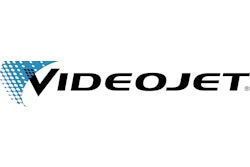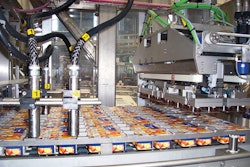Among the technology highlights at the Heilbronn, Germany, facility of the Dutch dairy cooperative Campina GmbH is a unique aseptic thermoform/fill/seal system featuring servo-driven nozzles that swirl as they dispense product.
Machinery builder Hassia (www.oystar.hassia.de), part of the Oystar group of companies, developed the 32-cavity tf/f/s machine when Campina indicated a wish to switch its popular swirled puddings out of preformed polystyrene cups and begin a tf/f/s operation instead. Among Campina’s goals was the wish to economize by not paying the added cost inherent in premade PS cups. But the firm also had marketing objectives that were easier to meet with the switch to tf/f/s.
We wanted a newer, more contemporary look,” says Martina Schilling, plant manager at the Heilbronn facility. “The preformed cup was only 75-millimeters in diameter, and it was multipacked by means of a paperboard carrier that ran only along the tops of the cups. It was very linear in appearance, just four cups lined up in a row, and graphic impact on the store shelf was minimal. Now we have a new and contemporary appearance that puts us in a much better position where the competition is concerned.”
But let’s get back to the swirl, which shows invitingly through the clear container. To achieve the swirl in the old package, a dual-port filling nozzle was used. This nozzle stayed stationary, and the individual cups were rotated to achieve the swirl. In switching out of preformed cups and moving instead to tf/f/s, rotating the cups was simply not an option because the cups are still part of a large matrix of freshly formed cups at the point where they are filled.
“When we decided we wanted to adopt this new packaging format, we knew it would require new technology,” says Horst Breitenoder, engineering manager at Campina Heilbronn. “So we brought in the suppliers we thought could do the job. Three offers were seriously considered, and Hassia’s we picked as the best.”
According to Schilling, it helped considerably that Campina had recently installed a Hassia system at another facility and that a widespread Campina goal is machine standardization where possible. “It makes no sense to have machines from a variety of suppliers operating in your plants,” says Schilling. “If you can bring some measure of standardization to your operations, you can more effectively manage such things as future costs, technical support, and technology developments you may need in the future.”
Schilling says Hassia’s reputation also helped a lot. “Their equipment is approved for things like baby food in the U.S., where FDA requirements are quite stringent,” says Schilling.
Steam sterilizing
For engineer Breitenoder, one additional element factored in heavily. “The Hassia system sterilizes packaging materials with steam rather than using such things as hydrogen peroxide,” he says. “Everything we see and hear about impending regulatory trends tells us that emissions of any kind, even those from hydrogen peroxide, are going to be discouraged. This machine positions us favorably from an emissions standpoint.”
He hastens to add that hydrogen peroxide is indeed used for periodic clean-in-place sterilization procedures. But the amount required is minimal compared to an aseptic filling system that sterilizes packaging materials by way of hydrogen peroxide.
One final bit of engineering expertise that Hassia brought to the table, say Schilling and Breitenoder, is the ability to use servo technology—it comes from Elau (www.elau.com)—to bring about the complicated swirling action of the filling nozzles. A total of 21 servo drive/motor pairs operate along the 75-ft. length of the TAS 32/80, though only two of them are required to twirl the machine’s 32 nozzles.
Managing director of Campina Deutschland Norbert Reuss sums up the selection process that led to the installation of the TAS 32/80 this way: “We needed to consolidate the machines used in our corporate group, and we also needed systems we could depend on. Hassia’s flexibility and innovativeness were also important reasons.”
Worth noting is that the Hassia TAS 32/80 is fully capable of producing shelf-stable aseptic packs in barrier materials that require no refrigeration throughout their one-year shelf life. But the Campina installation is more accurately described as extended-shelf-life (ESL) packaging because finished packs are stored, shipped, and merchandised under refrigerated conditions, and shelf life is 60 days maximum. This is done primarily because consumers in Germany do not expect to find single-serve dessert puddings outside of the refrigerated case. Recognizing this marketplace reality, Campina fills the dessert puddings under aseptic conditions because quality, freshness, and taste are all best maintained that way. But knowing the consumer wants this particular product in the refrigerated case, Campina does not use the more costly barrier materials that would be required for a one-year shelf life at ambient temperatures, and they code their product with a 60-day shelf life.
Operation begins
Filling begins at the unwind stand of the Hassia TAS 32/80 system. On it sits a large roll of clear PS measuring more than 7ft. in diameter. Cedap (www.cedap.mc) supplies the 900-micron material.
As the forming web is pulled into the machine, saturated steam sterilization at 300°F is the first treatment it undergoes. A short distance later is a preheat section, followed by contact heating plates that bring the material to about 285°F so that it can be thermoformed. Forming is done in a pattern of eight across and four in the machine direction.
The film now passes beneath three completely independent filling stations, F12, F13, and F14. With these stations at its disposal, Campina can fill 125-g (4.4-oz) cups in three formats:
• with a single product variety—chocolate or vanilla, for example
• with a swirled product, where two pudding flavors or pudding plus whipped cream are combined in one cup
• with one product on top of another product plus a topping added in the third station Operating speed is in the range of 26 cycles/min.
Lidding material is a 28-micron metallized polyester. Supplied by Constantia Hueck (www.hueck-folien.de), it’s gravure-printed in six colors. “We had been using a foil-based lidding material,” says Martina. “But along with this new Hassia system, we switched to the metallized polyester. It offers better peel properties in the consumer’s hands, and it’s less costly. We had to work pretty closely with Constantia and Hassia to make sure the film properties would be suitable for the steam sterilization.”
Another area of special focus when swirled products are being filled revolves around pressure settings.
“Constant pressure in filling is important,” says Schilling, “especially in getting the clear line of differentiation between chocolate and whipped cream. Keeping the machine running constantly helps a lot in this regard. Each stop we make just complicates this process.”
Date coding
Cups exit the Hassia system shortly after the punch station that cuts them from the web of PS forming material. A laning system causes cups to move from eight lanes to four so that four Videojet (www.videojet.com) ink-jet nozzles can date code the lids of each cup.
Cups now move into the sleeving system, which was provided by Wilhelm Fischer (www.wilhelm-fischer.de). It neatly stacks one two-count unit on top of another and then wraps the four cups in a paperboard sleeve. Date and production codes are also applied—once again by a Videojet system—to the paperboard sleeves.
Sleeved cups are conveyed next to a robotic tray packer from Schaeffer & Flottman (www.sfs-net.de) that puts 10 multipacks into a corrugated tray. From there, it’s on to warehousing and distribution.
And how many operators are required on the line? “We still have two, but we aim to have one plus a person who is assigned primarily to the tak of replenishing packaging materials,” says Schilling.
It’s hard not to be impressed by such numbers, especially when you factor in the magnitude of the line and its 700-cups/min operating rate. But maybe this kind of sophisticated automation is what it takes to succeed in today’s competitive climate. Campina Deutschland managing director Reuss puts it this way: “By investing in first-of-its-kind technology like this, we put another hurdle between ourselves and our competition. Not just a technical hurdle, but a capital investment hurdle, too.”


























